不定式、动名词、过去分词 作定语的用法
非谓语动词作定语和宾语补足语总结
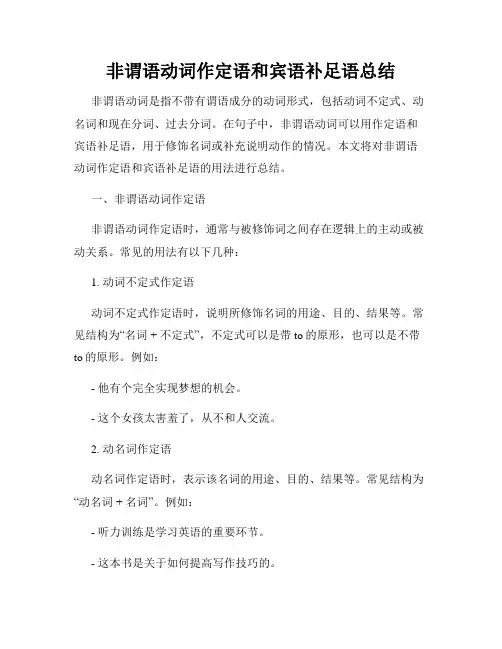
非谓语动词作定语和宾语补足语总结非谓语动词是指不带有谓语成分的动词形式,包括动词不定式、动名词和现在分词、过去分词。
在句子中,非谓语动词可以用作定语和宾语补足语,用于修饰名词或补充说明动作的情况。
本文将对非谓语动词作定语和宾语补足语的用法进行总结。
一、非谓语动词作定语非谓语动词作定语时,通常与被修饰词之间存在逻辑上的主动或被动关系。
常见的用法有以下几种:1. 动词不定式作定语动词不定式作定语时,说明所修饰名词的用途、目的、结果等。
常见结构为“名词 + 不定式”,不定式可以是带to的原形,也可以是不带to的原形。
例如:- 他有个完全实现梦想的机会。
- 这个女孩太害羞了,从不和人交流。
2. 动名词作定语动名词作定语时,表示该名词的用途、目的、结果等。
常见结构为“动名词 + 名词”。
例如:- 听力训练是学习英语的重要环节。
- 这本书是关于如何提高写作技巧的。
3. 现在分词作定语现在分词作定语时,表示所修饰名词正在进行的动作或状态。
常见结构为“现在分词 + 名词”。
例如:- 拉着行李箱的女人是我的妈妈。
- 那个躺在床上的男孩是我的弟弟。
4. 过去分词作定语过去分词作定语时,表示所修饰名词已经完成的动作或状态。
常见结构为“过去分词 + 名词”。
例如:- 这本被翻阅过许多次的书籍是我的宝贝。
- 我看过的那部电影非常精彩。
二、非谓语动词作宾语补足语非谓语动词作宾语补足语时,用于补充说明宾语的动作或状态。
常见的用法有以下几种:1. 动词不定式作宾语补足语动词不定式作宾语补足语时,说明宾语完成的动作。
常见的结构为“动词 + 宾语 + 不定式”。
例如:- 我喜欢听音乐。
- 她希望学好英语。
2. 动名词作宾语补足语动名词作宾语补足语时,表示宾语的动作或状态。
常见结构为“动词 + 宾语 + 动名词”。
例如:- 我通常喜欢读书。
- 他不值得你浪费时间。
3. 现在分词作宾语补足语现在分词作宾语补足语时,表示宾语正在进行的动作。
高二英语非谓语动词整理

To see is to believe.百闻不如一见。
To work means to earn a living.工作就是为了生活。
3)如果主语是以aim, duty, hope, idea, happiness, job, plan, problem, purpose, thing, wish等为中心的名词,或以what引导的名词性从句,不定式作表语是对主语起补充说明 作用。
loathe非常讨厌,厌恶 recall回想
例如:I appreciate having been given the opportunity to study abroad two years ago.我很感激两年前给我出国学习的机会。
(3)有些动词后使用动名词和动词不定式作宾语的差别
1)forget to do 忘记要去做某事(此事未做)
begin开始 expect期望 omit忽略,漏
appear似乎,显得 determine决定 manage设法
cease停止 hate憎恨,厌恶 pretend假装
ask问 dread害怕 need需要
agree同意 desire愿望 love爱
swear宣誓 volunteer志愿 wish希望
2)下面的动词要求不定式做宾补:动词+宾语+动词不定式
ask要求,邀请 get请,得到 prompt促使
allow允许 forbid禁止 prefer喜欢,宁愿
announce宣布 force强迫 press迫使
bride 收买 inspire鼓舞 request请求
assist协助 hate憎恶 pronounce断定,表示
不定式动名词和过去分词作定语的比较
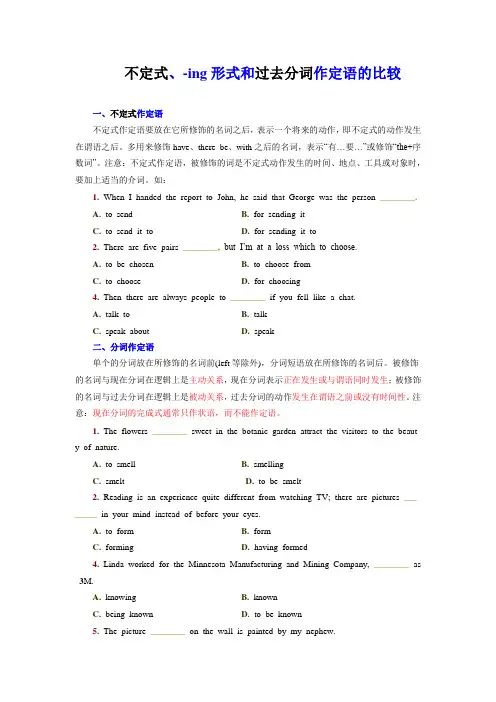
不定式、-ing形式和过去分词作定语的比较一、不定式作定语不定式作定语要放在它所修饰的名词之后,表示一个将来的动作,即不定式的动作发生在谓语之后。
多用来修饰have、there be、with之后的名词,表示“有…要…”或修饰“the+序数词”。
注意:不定式作定语,被修饰的词是不定式动作发生的时间、地点、工具或对象时,要加上适当的介词。
如:1.When I handed the report to John, he said that George was the person________.A. to sendB. for sending itC. to send it toD. for sending it to2.There are five pairs________,but I’m at a loss which to choose.A. to be chosenB. to choose fromC. to chooseD. for choosing4.Then there are always people to________ if you fell like a chat.A. talk toB. talkC. speak aboutD. speak二、分词作定语单个的分词放在所修饰的名词前(left等除外),分词短语放在所修饰的名词后。
被修饰的名词与现在分词在逻辑上是主动关系,现在分词表示正在发生或与谓语同时发生;被修饰的名词与过去分词在逻辑上是被动关系,过去分词的动作发生在谓语之前或没有时间性。
注意:现在分词的完成式通常只作状语,而不能作定语。
1.The flowers________ sweet in the botanic garden attract the visitors to the beaut y of nature.A. to smellB. smellingC. smeltD. to be smelt2.Reading is an experience quite different from watching TV; there are pictures___ _____ in your mind instead of before your eyes.A. to formB. formC. formingD. having formed4.Linda worked for the Minnesota Manufacturing and Mining Company,________ as 3M.A. knowingB. knownC. being knownD. to be known5.The picture________ on the wall is painted by my nephew.A. having hungB. hangingC. hangsD. being hung6.The disc, digitally________ in the studio, sounded fantastic at the party that night. (上海卷)A. recordedB. recordingC. to be recordedD. having recorded7.The first textbooks________ for teaching English as a foreign language came out in the 16th century.A. having writtenB. to be writtenC. being writtenD. written三、to be done, being done, done作定语的区别to be done表示将来,being done表示目前正在发生,done表示过去己经发生。
不定式,动名词,分词
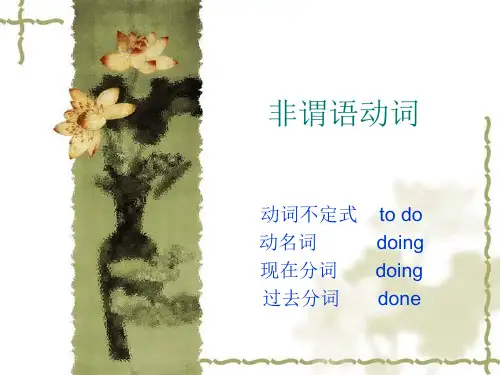
表语 Don’t touch the glass because it is broken. 定语 The excited people rushed into the building. 状语 Seen from the top of the hill, the city looked like a big garden. 补足语 When you are making a speech, you should speak louder to make yourself heard.
9. 分词 9.1 分词作定语
分词前置 如: We can see the rising sun. 我们可以看到东升的旭日 He is a retired worker. 他是位退休的工人 分词后置 (i分词词组;ii 个别分词如given, left; iii 修饰不定代词 something等) 如: There was a girl sitting there. 有个女孩坐在那里 This is the question given. 这是所给的问题 There is nothing interesting. 没有有趣的东西
过去分词作定语 与其修饰的词是被动关系,相当 于一个被动语态的定语从句。 如: Most of the people invited to the party were famous scientists.
典型例题
1) The first textbook ___ for teaching English as a D foreign language came out in the 16th century. A. have written B. to be written C. being written D. written 答案D. 书与写作是被动关系,应用过去分词做定 语表被动,相当于定语从句 which is written
不定式分词的用法
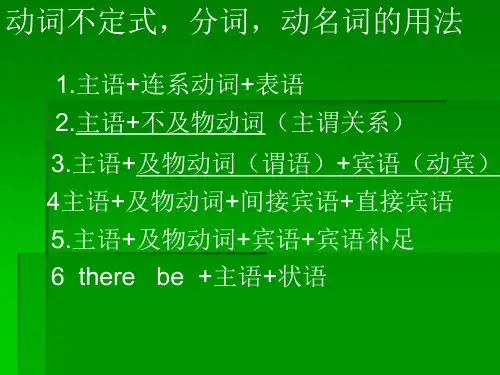
3. They force the enemy to give up their arm.
The enemy was forced to give up their arms
Please tell her to go there.
Let me help you.
They heard him sing a pop song in the meeting room.
注:若see,hear, notice, observ,make,have 变为被动语态,其后的不定式不能省略to
主语
to support a large family.
2. the most important thing is to put more heart into your work
表语
3. All the child in class one hope to be of some help to you.
1. I forgot p_o_s_t_in_g__(post)the letter and thought I had left it at home.
2. Please post the letter for me, I forgot _to__p_o_s_t __(post)it this morning.
用动词的适当形式填空
1.I consider myself fortunate to _b_e_w_o_r_k_in_g__(work) with you now
不定式、动名词、过去分词作定语的用法
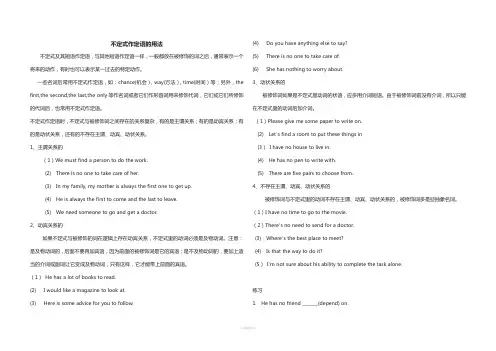
不定式作定语的用法不定式及其短语作定语,与其他短语作定语一样,一般都放在被修饰的词之后,通常表示一个将来的动作,有时也可以表示某一过去的特定动作。
一些名词后常用不定式作定语,如:chance(机会),way(方法),time(时间)等;另外,the first,the second,the last,the only等作名词或者它们作形容词用来修饰代词,它们或它们所修饰的代词后,也常用不定式作定语。
不定式作定语时,不定式与被修饰词之间存在的关系复杂,有的是主谓关系;有的是动宾关系;有的是动状关系,还有的不存在主谓、动宾、动状关系。
1、主谓关系的(1)We must find a person to do the work.(2) There is no one to take care of her.(3) In my family, my mother is always the first one to get up.(4) He is always the first to come and the last to leave.(5) We need someone to go and get a doctor.2、动宾关系的如果不定式与被修饰的词在逻辑上存在动宾关系,不定式里的动词必须是及物动词。
注意:是及物动词的,后面不要再加宾语,因为前面的被修饰词是它的宾语;是不及物动词的,要加上适当的介词或副词让它变成及物动词,只有这样,它才能带上前面的宾语。
(1)He has a lot of books to read.(2) I would like a magazine to look at.(3) Here is some advice for you to follow. (4) Do you have anything else to say?(5) There is no one to take care of.(6) She has nothing to worry about.3、动状关系的被修饰词如果是不定式里动词的状语,应多用介词短语。
非谓语的用法
非谓语的用法一、什么是非谓语?非谓语是指在句子中不作谓语的动词形式,包括动词的不定式、动名词和分词。
二、动词不定式的用法1. 作主语:To learn English well is necessary.2. 作宾语:I want to go to the cinema.3. 作表语:His dream is to be a doctor.4. 作定语:The best way to learn English is to practice speaking.5. 作状语:(1)目的状语:He went to the library to borrow some books.(2)结果状语:He studied hard, only to fail the exam in the end.(3)原因状语:He got up early so as not to miss the train.6. 不定式的否定形式为“not+动词原形”,常用于否定意义。
三、动名词的用法1. 动名词可以作主语、宾语和表语。
(1)主语:Reading books is a good habit.(2)宾语:I enjoy reading books in my free time.(3)表语:Her hobby is swimming in the sea.2. 动名词可以与介词搭配构成介词短语,表示时间、原因、方式等。
(1)时间状语:After finishing his homework, he went to bed. (2)原因状语:For lack of money, he couldn’t buy a new car.(3)方式状语:By working hard, he got a promotion.四、分词的用法1. 现在分词和过去分词可以作定语和状语。
(1)现在分词作定语:The running water is very clear.(2)现在分词作状语:He left the room, closing the door behind him.(3)过去分词作定语:The broken vase cannot be repaired.(4)过去分词作状语:Feeling tired, he went to bed early.2. 分词也可以与连系动词be搭配构成表语。
不定式、分词、动名词用法
英语中,非限定动词也叫非谓语动词,也就是不定式、分词和动名词。
顾名思义,不定式、分词和动名词在英语句子中是不能做作谓语的。
一、基本形式a.不定式的基本形式是“小品词to﹢动词原形”即to﹢v. ;但有时也可省去to, 即:(to) ﹢v. 。
b.分词有两种基本形式:现在分词(the present participle)和过去分词(the past participle)。
①现在分词的基本形式是动词的—ing形式,如,writing, doing ,working ,going, etc.②过去分词的基本形式是:a) 规则动词﹢ed, 即v.-ed, 如,visit→visited ,ask→asked ,dig→digged ,etc; b) 不规则动词有其自身的过去式和过去分词,学生需要用心熟记,方能正确使用。
如,go →went→gone; do→did→done, etc .c.动名词的基本形式与现在分词的基本形式相同,都是动词的—ing 形式,如,doing ,writing ,doing ,etc .二、时态、语态及其基本用法A. 不定式1.不定式的时态、语态有三种形式:①一般式,如,to write / to be written ;②进行式,如,to be writing / to have been writing;③完成式,如,to have written / to have been written 。
2.基本用法①不定式的一般式,表示的动作与谓语动词表示的动作同时发生,有时也发生在谓语动词表示的动作之后。
如:He seems to know this.(=It seems that he knows this.)I hope to see you again.(=I hope that I’ll see you again.)He doesn’t like to be laughed at. (=He doesn’t like that he is being laughed at.)②不定式的进行式,表示不定式的动作正在进行,与谓语动词表示的动作同时发生。
英语非谓语动词:不定式,动名词和分词
英语非谓语动词:不定式,动名词和分词非谓语动词分为三种形式:不定式、动名词和分词(包括现在分词和过去分词)(一)动词不定式动词不定式可以作主语、宾语、宾语补足语、定语、状语、表语。
动词不定式由“to+动词原形”构成,否定形式“not to +动词原形”。
1.用法(1)作主语。
往往用it作为形式主语。
如:It is time to get up.(2)作宾语。
如果带有宾语补足语,往往把不定式短语放在宾语补足语之后,用it作形式宾语。
如:I find it interesting to study English.有些动词只能用动词不定式作宾语。
如:decide,plan,desire,hope,wish,promise,ask,agree, manage等。
(3)作宾语补足语A:带to的动词不定式有:ask,tell,want,teach,advise,allow,beg,invite等。
如:He asked me to do the work.B :接不带to的动词不定式有:see,watch,hear,make ,let等。
如:I often see him play football.使役动词不带to,动词有:一感二听三让四观看。
一感:feel 二听:hear, listen to 三让:let,have,make 四观看:observe,see,watch,look at注意:feel, hear,notice, see,watch,have,make等词后的补足语中,不定式不带to,但变成被动结构时,要带to.如:I often hear him cry. He is often heard to cry.注意:带but介词的不定式。
如果介词之前有行为动词do的各种形式,那么but后的不定式不带to,否则要带to。
另外,在can’t choose but...和can’t help but...等后面的不定式也省略to。
动名词和不定时 现在分词和过去分词
动名词与不定式的区别:动名词起名词作用,在句子中可以作主语、宾语、表语、定语、主语补足语、宾语补足语。
不定式起名词、形容词、副词作用,在句子中出了动名词起的作用外,还可以作状语。
但两者之间也有差别:(一)不定式的逻辑主语必须与主语一致,而动名词的逻辑主语范围较大,它可以指主语,也可以是泛指。
如:I hate to work on weekends. 我讨厌周末干活。
(指自己干活)I hate working on weekends. 我讨厌周末干活。
(可以指自己,也可以泛指)(二)动名词多指抽象的、概念性的动作,可以是多次的、经常的动作,不定式多表示具体的动作,尤其是某一次的动作。
如Reading in bed is a pleasure. 躺着看书是一种乐趣。
I like swimming but I don’t like to swim in the pool today.我喜欢游泳,但是今天我不喜欢在游泳池里游泳。
试比较:Playing with fire is dangerous. 玩火危险。
(泛指玩火)To play with fire will be dangerous. 玩火会发生危险。
(指一具体的动作)Talking for hours at a stretch is more exhausting than you seem to think.一连讲几个小时的话会比你想象的似乎要累。
(泛指讲话)To talk for hours at a stretch is more exhausting than you seem to think.一连讲几个小时的话会比你想象的似乎要累。
(指个人的感受)(三)在某些动词后面只能用动名词,而另一些动词之后只能用不定式。
后接动名词的动词有:admit, avoid, consider, defer, delay, deny, dislike, enjoy, escape, fancy, finish, imagine, include, keep, mind, miss, postpone, practise, recall, recollect, resent, resist, risk, stop, suggest 等;短语动词有have done, give up 等。
- 1、下载文档前请自行甄别文档内容的完整性,平台不提供额外的编辑、内容补充、找答案等附加服务。
- 2、"仅部分预览"的文档,不可在线预览部分如存在完整性等问题,可反馈申请退款(可完整预览的文档不适用该条件!)。
- 3、如文档侵犯您的权益,请联系客服反馈,我们会尽快为您处理(人工客服工作时间:9:00-18:30)。
不定式作定语的用法不定式及其短语作定语,与其他短语作定语一样,一般都放在被修饰的词之后,通常表示一个将来的动作,有时也可以表示某一过去的特定动作。
一些名词后常用不定式作定语,如:chance(机会),way(方法),time(时间)等;另外,the first,the second,the last,the only等作名词或者它们作形容词用来修饰代词,它们或它们所修饰的代词后,也常用不定式作定语。
不定式作定语时,不定式与被修饰词之间存在的关系复杂,有的是主谓关系;有的是动宾关系;有的是动状关系,还有的不存在主谓、动宾、动状关系。
1、主谓关系的(1)We must find a person to do the work.(2) There is no one to take care of her.(3) In my family, my mother is always the first one to get up.(4) He is always the first to come and the last to leave.(5) We need someone to go and get a doctor.2、动宾关系的如果不定式与被修饰的词在逻辑上存在动宾关系,不定式里的动词必须是及物动词。
注意:是及物动词的,后面不要再加宾语,因为前面的被修饰词是它的宾语;是不及物动词的,要加上适当的介词或副词让它变成及物动词,只有这样,它才能带上前面的宾语。
(1) He has a lot of books to read.(2) I would like a magazine to look at.(3) Here is some advice for you to follow.(4) Do you have anything else to say?(5) There is no one to take care of.(6) She has nothing to worry about.3、动状关系的被修饰词如果是不定式里动词的状语,应多用介词短语。
由于被修饰词前没有介词,所以只能在不定式里的动词后加介词。
(1)Please give me some paper to write on.(2) Let’s find a room to put these things in(3) I have no house to live in.(4) He has no pen to write with.(5) There are five pairs to choose from.4、不存在主谓、动宾、动状关系的被修饰词与不定式里的动词不存在主谓、动宾、动状关系的,被修饰词多是些抽象名词。
(1)I have no time to go to the movie.(2)There’s no need to send for a doctor.(3) Where’s the best place to meet?(4) Is that the way to do it?(5) I’m not sure about his ability to complete the task alone.练习1. He has no friend _______(depend) on.2. He is not the kind of man (do) such things.3. I have a lot of work (finish) today.4. There is a good rule ( go ) by.5. Thank you for giving me the chance (make) the speech.6. She is always the first ( answer ) questions.7. Can you find a proper person ( finish) this job in time动词的-ing形式做定语动词的-ing形式做定语在句中通常有两个位置,如果是单个的动词的-ing形式做定语,常放在被修饰词前做前置定语;如果是动词的-ing形式的短语做定语,常放在被修饰词后做后置定语。
如: 1.He is an attacking player.他是一个攻击型的运动员。
2.He asked an embarrassing question.他提了一个令人难堪的问题。
3.A little child learning to walk often falls.学走路的小孩常常跌跤。
4.Do you know the number of people coming to the party?你知道来参加晚会的人数吗? 注意:当-ing形式做后置定语时,可以相当于相应的定语从句。
如: 1.A young man writing novels came to speak to us yesterday. →A young man who writes novels came to speak to us yesterday. 一位写小说的青年昨天来向我们作报告。
2.The girl sitting next to me was my cousin. →The girl who was sitting next to me was my cousin.坐在我旁边的姑娘是我表妹。
-ing形式做定语通常从以下三方面考查,即: 1)说明被修饰词的性质,特征或用途。
如: 1.They set up an operating table in a small temple.他们将手术台架设在一座小庙里。
2.He may be in the reading room,for all I know.他说不定在阅览室里。
dies and gentlemen,please go and wait in the meeting room.女士们先生们,请去会议室等待。
2)与被修饰词为主动关系且表示正在进行的动作。
如: 1.There were about 200 children studying in the art school.有大约二百个孩子在这所艺术学校学习。
2.Who is the woman talking to our English teacher? 正在和我们英语老师谈话的那位妇女是谁?练习:1.The lady said she would buy a gift for her daughter with the _____.A.20 dollars remainedB.20 dollars to remainC.remained 20 dollarsD.remaining 20 dollars.2.The wild flowers looked like a soft orange blanket ______ the desert.A.coveringB.coveredC.coverD.to cover3.I was told that there were about 50 foreign students ____ Chinese in the school,most _____ were from Germany.A.study;of whomB.study;of themC.studying;of themD.studying;of whom 4.The question ______ at present has something important to do with our daily life.A.to be discussingB.to discussC.been discussedD.being discussed 5.China is a_____country______to the third world.A.developed;belongsB.developing;belongingC.developing;belongsD.developed;belonged 6.---Who is the man______to the teacher? ---A model worker_____our school.A.talks,visitsB.is talking;is visitingC.talking;visitingD.talking;visited 7.The flowers_____sweet in the garden attract the visitors to the beauty of nature.A.to smellB.smellingC.smeltD.to be smelt8. There are a few boys (swim) in the river.9. There is a car ( wait ) outside.10 .People (wait) for the bus often sheltered in my doorway.11. The boy (sit)behind me is my brother.12. The girl (swim) in the pool is my daughter过去分词作定语过去分词作定语有前置和后置两种情况.1、前置定语单个的过去分词作定语,通常放在被修饰的名词之前,表示被动和完成意义.a) 被动意义:an honored guest 一位受尊敬的客人The injured workers are now being taken good care of in the hospital. 受伤的工人现正在医院受到良好的照料.b):完成意义:a retired teacher 一位退休的教师They are cleaning the fallen leaves in the yard. 他们正在打扫院子里的落叶.2、后置定语过去分词短语作定语时,通常放在被修饰的名词之后,它的作用相当于一个定语从句.如:This will be the best novel of its kind ever written (=that has ever been written). 这将是这类小说中写得最好的.The people caught =(who was caught)by the police was a thief. 被警察抓获的那个人是个贼练习:1.-----Who would you like to see at the moment?------ The man_____ John.A. called himB. we call him C calling D. called2. The _____ glass cup was ______ by John.A. breaking; brokenB. breaking; breakingC. broken, brokenD. broken; breaking3. English is different from English in many ways.A. Spoken, writtenB. Speaking, writtenC. Spoken, writingD. Speak, write4. Prices of goods, through a computer, can be lower than store prices.A. are boughtB. boughtC. been boughtD. buying5. Cleaning women in big cities usually get by the hour.A. payB. payingC. paidD. to pay6. The trees _____ in the storm have been moved off the road.A. being blown downB. blown downC. blowing downD. to blow down7. With ______ leaves ______ in the earth every year, the soil becomes richer and richer.A. falling; buryingB. fallen; buriedC. fallen; buryingD. falling; buried8. She asked if there was anything _______ for tonight.A. to planB. plannedC. that plansD. planning9.I smell something __________ in the kitchen. Can I call you back in a minute?A. burningB. burntC. being burntD. to be burnt10. He felt very ______after finishing his work.A excitedB excitingC exciteD badly。
